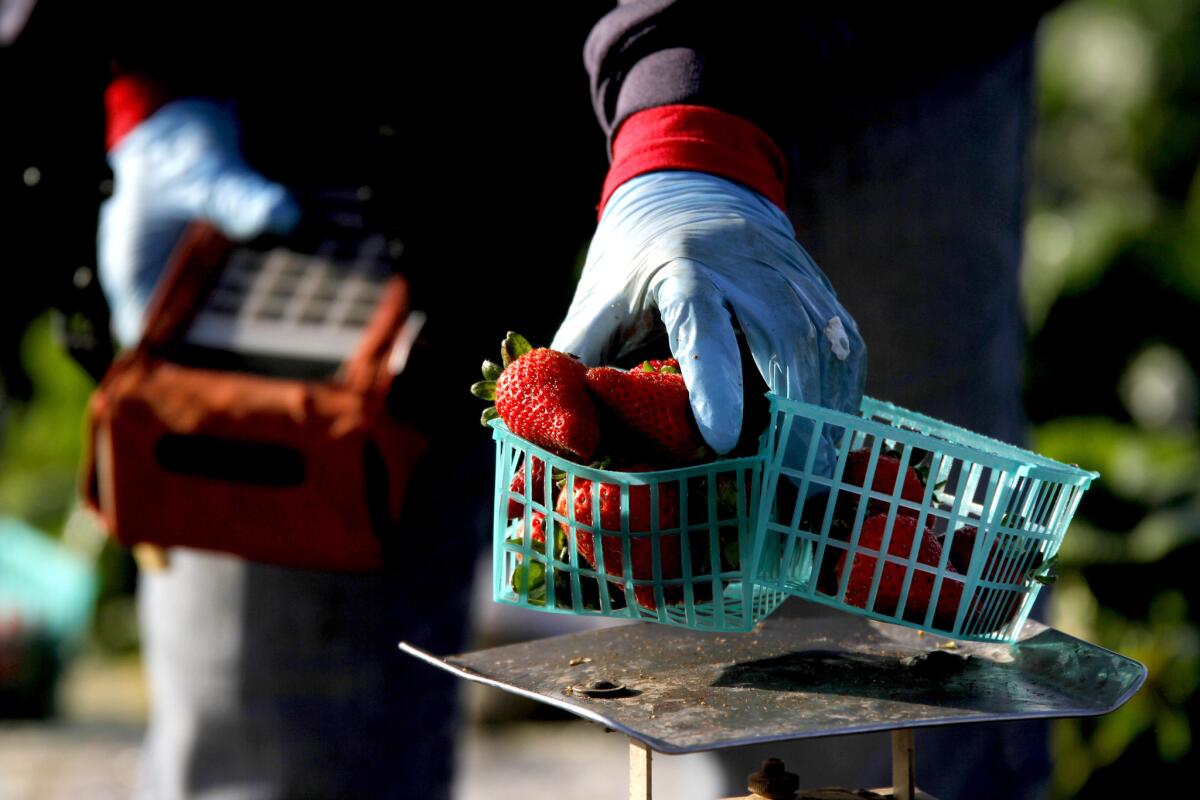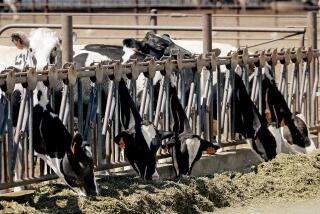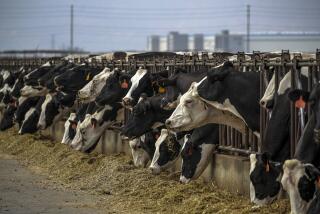Will coronavirus affect food supply? First problem: A possible shortage of workers

California’s nearly $50-billion agricultural industry is bracing for a potential labor shortfall that could hinder efforts to maintain the nation’s fresh produce supply amid the widening coronavirus outbreak.
The immediate concern centers on a backlog in the recruitment of foreign guest workers because of the virus-related shutdown of consul offices processing agricultural H2-A visas in Mexico.
The expected bottleneck in recruitment of temporary agricultural workers arises weeks before harvest time for crops such as strawberries and lettuce that heavily depend on the foreign crews along the state’s central coast and in Salinas Valley, according to growers and labor contractors.
The fears highlight a gap in the Trump administration’s market-centered approach to keeping vital industries running, which includes numerous measures aimed at supporting aid, credit and the major commodity crops in the nation’s heartland. There has been little done to address the labor-intensive fresh food crops that form the backbone of California agriculture.
Amid uproar from the agriculture industry this week, the U.S. Department of Agriculture pressed the State Department to continue processing H-2A visas even as it closed consulates across the border region. So far, State has responded by promising to waive in-person interview requirements for H-2A applicants who obtained visas last year. That’s about half the H-2A workforce, according to industry trade groups.
“The U.S. Consulate General, Monterrey, announced that they will prioritize the processing of returning H-2 workers who are eligible for an interview waiver,” a USDA spokesman said Tuesday. “Otherwise, the administration will continue to examine what authorities are available while ensuring public safety and health.”
Assurance from USDA and State were not enough to satisfy growers, shippers and contractors in California, who have been pressing for more clear answers as the scope of the pandemic comes into focus. The state has faced years of labor shortages caused by the aging of the local workforce, immigration crackdowns, improvements in job prospects in Mexico and other factors.
“We don’t have enough H-2A workers coming across in normal times,” said Dave Puglia, president of the Western Growers Assn., a regional agricultural trade group.
California recruited more than 23,000 H-2A workers in the fiscal year that ended in October, placing the state fourth behind Florida, Georgia and Washington, respectively, according to the U.S. Labor Department.
“A halt or a drastic slowdown in processing visas will have an immediate domino effect of the domestic food supply of this country,” said David Scaroni, vice president of Fresh Harvest, the country’s largest private contractor of H-2A workers. “No emergency declaration or short term provision will change this fact.”
Most of the laborers contracted by Fresh Harvest are veterans of other seasons, giving the company hope that most applicants will be eligible for waivers. Any shortfall or slowdown, however, would have a cascade effect across production, harvest, processing and distribution within weeks, Scaroni said. “Plants already in the ground do not know that there is a pandemic occurring. It is crucial to keep this process going as close to the prior normal to ensure a stable food supply for the coming months.”
The next few weeks will be crucial — labor contracting surges dramatically as produce shifts from the winter desert regions of California and Arizona and gets underway along the central coast. That region hosts the bulk of the state’s strawberry production and much of its spring and summer leafy greens, broccoli and cauliflower, among other crops.
Guest workers make up a tiny fraction of the estimated 420,000 farmworkers in the state. But that figure masks deep, short-term dependency within crops and harvest areas, particularly the fertile coastal valleys from Ventura County’s Oxnard plain through the Santa Maria Valley in Santa Barbara and San Luis Obispo counties, to the Salinas Valley in Monterey County.
On Tuesday night, Monterey County adopted a “shelter-in-place” ordinance similar to measures enacted already in the San Francisco Bay Area. Other counties with significant agricultural sectors likewise adopted the restrictive measures, including Sacramento, Yolo, Sonoma, Marin, San Benito, Santa Cruz, Santa Clara, and San Mateo counties.
Christopher Valadez, president of the Grower-Shipper Assn. of Central California, an industry group in Salinas, said he scrambled to assure that early adopters of restrictive ordinances exempt all sectors of the food supply chain from their prohibitions on crowds and personal interactions. Several of the Bay-Area counties appeared to have overlooked food processing, which can include anything from chopping and mixing greens in prepared salad bags to making pizza sauce from tomatoes.
Monterey County’s ordinance, crafted with substantial industry input, included a wide exemption for agriculture.
“We believe because of what’s planted and what’s going to be harvested that we can meet the demand and maintain the continuity of the food supply,” Valadez said. “The question is the labor equation. The crops are going to be there. But what are we going to be able to do to get the crops out of the ground?”
Carole Shandler, chief executive of SGS Produce in Los Angeles, said she was pleasantly astonished when her workforce of about 90 pledged to stay on the job. “I gave them the option of staying at home. They were like, ‘We’re gonna work. We’re gonna feed the country.’
“A lot of places, like food service and purveyors, they’re like a ghost town.”
Supply has remained steady, even as demand spiked, especially for winter-type and high-starch produce — potatoes, onions, squash and the like, Shandler said.
The California Leafy Greens Marketing Agreement, a quasi-governmental body that regulates the greens industry, echoed that message and highlighted its hygiene regime. Its rules include mandatory hand-washing instruction for workers, clean bathroom facilities stocked with water, soap, toilet paper, and towels, prohibitions against eating, chewing tobacco or spitting in fields, and regular sanitizing of equipment.
Those rules were already in place to prevent food-borne illness outbreaks that have struck the industry in the last three years but are equally effective against the spread of contagious diseases among workers.
There is no evidence that contact with produce is contributing to the spread of coronavirus, federal health and safety agencies have said.
The United Farm Workers union said hygiene practices and worker protection are hardly uniform across California crops and fields.
“Historically, farmworkers are so used to not having healthcare they just put up with being sick,” said Armando Elenes, secretary-treasurer of the United Farm Workers. “They’re going to go to work, and on the way to work, they’ll be in a car with four, five or six workers. So ‘social distancing’? Forget that.”
Workers seeking information from employers are not getting it, while they are bombarded with rumors on social media, Elenes said. They also report being asked for doctors’ notes or facing ridicule for asking for any of the 24 hours of paid sick leave mandated by law, Elenes said.
Coronavirus cases have been confirmed in agricultural counties across the state, such as San Diego, Sacramento, Riverside, Imperial, Ventura, Santa Barbara, Fresno, Marin, Monterey, San Joaquin, San Luis Obispo, Solano, Sonoma, San Benito, Stanislaus, Tulare and Yolo.
There is no indication the virus has so far reached farmworkers themselves. Community Health Centers of the Central Coast had no confirmed cases among the 110,000 rural patients served at 31 clinics in Santa Barbara and San Luis Obispo counties, said Steve Mahr, director of marketing and communication for the not-for-profit network.
About 40,000 of the network’s clients report their occupations as farmworkers, Mahr said. The network was setting up heated tents for triage at some of its 31 centers that don’t already have separate “sick rooms,” Mahr said.
Valadez said transportation from packing facilities appears to be operating well, a sentiment confirmed by large shippers contacted by The Times. Two reported an uptick in demand consistent with supplying grocery stores beset by panic buyers. The Trump administration has suspended time limitations on truck drivers as part of its virus response.
An agriculture industry source said operations dependent on food-service clients could suffer irreparable economic harm. The inability of the retail side to absorb the unused supply could leave a paradox of empty bins in grocery stores while food rots in the fields.
Rabobank Research predicts that effects of the pandemic will last several months. It already has affected parts of the food economy few think about, such as the boxes it’s packed in — cardboard production largely halted in China in January and February, driving up prices.
Aside from the concerns about the coronavirus outbreak, growers were dealing with a more familiar uncertainty: weather. Wholesalers report that unusually heavy rains have created an “extreme” market for many produce items, including carrots, peppers, squash, potatoes and cauliflower. California’s citrus industry has had to slow or pause harvest during the prolonged rains of the last week, according to California Citrus Mutual. The industry had hoped to overcome most of the supply imbalances as it shifted production north and into additional states. Then the pandemic hit.
More to Read
Inside the business of entertainment
The Wide Shot brings you news, analysis and insights on everything from streaming wars to production — and what it all means for the future.
You may occasionally receive promotional content from the Los Angeles Times.











